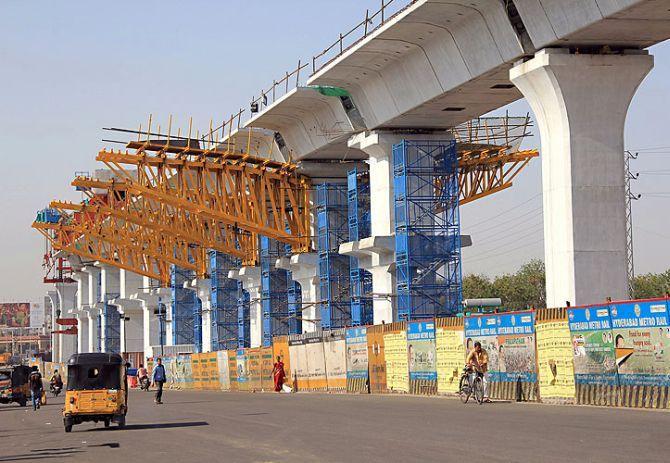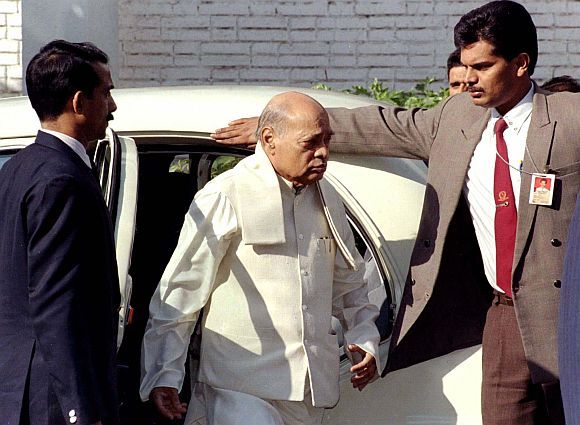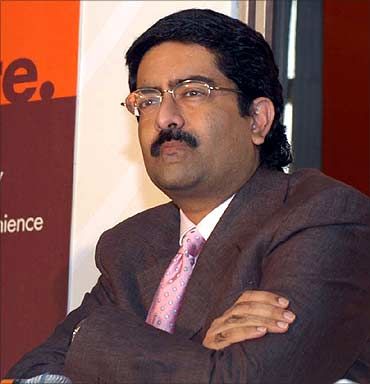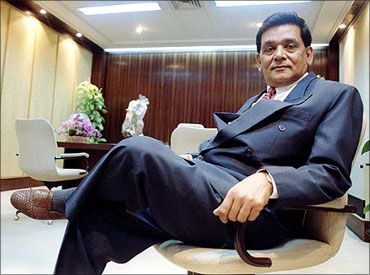Larsen & Toubro has managed to fend off hostile takeover bids from renowned corporate groups in the past 4 decades.

In 1987, a move by Manu Chhabria to pick up a one per cent stake in Larsen & Toubro (L&T) triggered multiple controversies that ended only 16 years later in 2003, after many riveting political and boardroom dramas.
By then, two of the corporate protagonists were dead and employees of the giant engineering conglomerate had taken charge of its destiny Dubai-based Chhabria had burst on the Indian business scene only two years before with a series of high-profile buys like Shaw Wallace, Dunlop, Hindustan Dorr-Oliver, to name a few.
His entry, however, was less than welcome for India's professional managers not least because of his brash management style.
So, when Chhabria turned his attentions to the blue-chip L&T, a company that had been established in 1938 by two Danish engineers but lacked identifiable promoters and an attractive target for takeover tycoons, the company's management duly reacted.
 Chairman N M Desai asked Reliance Industries (RIL) Chairman, Dhirubhai Ambani to invest in the company's shares as a white knight.
Chairman N M Desai asked Reliance Industries (RIL) Chairman, Dhirubhai Ambani to invest in the company's shares as a white knight.
Now, Ambani, then well on his way to becoming one of India's most powerful businessmen, rarely let any opportunity pass and he immediately bought 12.4 per cent from the open market.
Backed by the Congress Party, Ambani continued to corner more shares from the open market and by 1989 increased his stake to 18.5 per cent by spending close to Rs 190 crore (Rs 1.90 billion).
Remember, all this took place long before the takeover code and market regulator Securities and Exchange Board of India came into play.
But Ambani was no white knight in the conventionally understood sense of the term. Armed with his sizeable stake, he immediately sought, and was granted, board seats for himself and for his sons Mukesh and Anil. It was Desai, the man who had invited Ambani on board, who paid the price for his defensive strategy. He was shunted out as chairman in favour of Dhirubhai.
L&T soon realised that the advent of the Ambanis may have warded off the threat from Chhabria but it was to be no picnic under the Ambani dispensation.
L&T was important for Reliance because the company was constructing RIL's petrochemicals complex.
But Ambani was also interested in L&T's substantial cash flows.
As chairman of L&T, one of Ambani's first decisions was to ask the company to grant RIL supplier's credit of Rs 570 crore (Rs 5.70 billion).
The cash-rich construction company was also asked to buy RIL shares worth Rs 76 crore (Rs 760 million) from the market from entities close to Reliance.
Another controversial decision by Ambani was to make L&T take on more debt.
But the party soon ended for the Ambanis.
In 1989, in a humiliating defeat, the Congress, led by the then Prime Minister Rajiv Gandhi, lost power to V P Singh. Soon it became clear that the new Prime Minister Singh was not a friend of the Ambanis or any big business, for that matter; Singh's tenure saw the revival of the raid raj.
 The government immediately asked state-owned Life Insurance Corporation, the dominant shareholder, to make sure that the Ambanis were out of L&T.
The government immediately asked state-owned Life Insurance Corporation, the dominant shareholder, to make sure that the Ambanis were out of L&T.
Ambani was forced to resign from the board and former State Bank of India chairman D N Ghosh was asked to replace him.
This was also the time when Ambanis were fighting a bitter battle with Nusli Wadia of Bombay Dyeing for supremacy in the petrochemicals business.
The Indian Express, led by its feisty Chairman Ramnath Goenka and editor Arun Shourie, wrote a series of exposes about RIL, its controversial takeover of L&T among them.
Meanwhile, under Ghosh, L&T immediately withdrew the supplier's credit to Reliance and started off-loading RIL shares in the market.
Though Dhirubhai's sons Mukesh and Anil were still on L&T's board, they soon realised that with a hostile government at the Centre, it was impossible to control the company, since the majority shareholding was still with government-owned institutions.

But luck favoured Ambani. V P Singh's minority government soon collapsed and was replaced in 1990 by Chandra Shekhar, who had closer links to the Ambanis.
Ghosh was asked to resign. The Supreme Court also ruled in Ambani's favour. But the economy was also in ruins as a result of a drain on the country's forex reserves.
With the general elections of 1991 bringing the Congress back to power in a minority government under PV Narasimha Rao , the Ambanis tried to make a comeback.
In June 1991, the Ambanis had enough shares and proxies to vote Dhirubhai Ambanai back as chairman and Mukesh as the managing director.
But following pressure from the Opposition, Prime Minister Rao decided to stay away from the battle. In fact, following orders from the then finance minister Manmohan Singh LIC sought an adjournment of the Extraordinary General Meeting in August 1991 which was to vote on bringing Ambanis back to L&T.
Shareholders close to Ambanis, however, refused to vacate the hall.
By then, the Ambanis also realised that it would not be possible for the Congress-led minority to openly support them. Hence, by September they decided to stay away from L&T and dropped resolutions to be installed as chairman and managing director.
After that, the Ambanis stayed on as passive investors in L&T for more than a decade. The calm seemed to have returned on L&T with professionals managing the company.
 But the Ambanis had one more surprise in store for the company.
But the Ambanis had one more surprise in store for the company.
In November 2001, the Ambanis abruptly sold their remaining 10.05 per cent stake in L&T to Kumar Mangalam Birla's Grasim.
Grasim was directly competing with L&T in the cement business, which is why it wanted to take over the company.
But Birla completely misunderstood one person: A M Naik, the doughty CEO & MD of the company appointed only three year before.
Born and educated in a Gujarat village, Naik was not to be cowed down by the corporate raiders.
He soon rallied L&T employees behind him and exhorted them to take destiny in their own hands.
Instead of remaining servants to others, Naik asked his employees to become owners of the company.
"We should perform so well that it should become impossible for anyone to buy shares in our company because good results will make the stock expensive," Naik told them.

Under Naik, L&T finally found its true leader from within. Naik fought Birla's entry into the company tooth and nail and made representations to everyone from the prime minister to LIC to let L&T retain its professional management culture.
After months of negotiations, Birla exited L&T by selling its stake to an employees' trust run by L&Ts employees in June 2003.
In return, Birlas received L&T's cement division and named it UltraTech.
It was a win-win deal for both.
The fate of L&T was finally in the hands of its own employees.
From then on, there has been no turning back for L&T and Naik.
Since June 2003, the market value of L&T has gone up 25 times, from Rs 6,000 crore (Rs 60 billion) to Rs 1,47,000 crore (Rs 1,470 billion) now, with its employees owning 12 per cent of the company.
That makes it impossible for anyone to make a hostile raid on it. Naik's dream to make L&T create its own destiny has finally come true.









